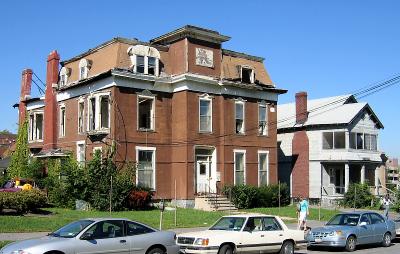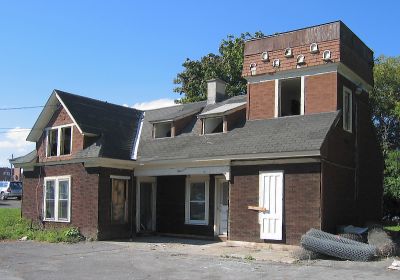|
SU to raze house with ties to school's past Sunday,
September 26, 2004 Dick Case, Post Standard Columnist How soon we forget. The two old houses on the west side of the 600 block of University Avenue make for lonesome profiles against the skyline of downtown. Not for long. Nos. 6021/2 and 604 University - former Syracuse University living centers - are to be torn down soon. SU got demolition permits from the city last week. The two buildings - also, there's a carriage house behind 604 - are the last vintage structures in the 600 block, shabby reminders of when the avenue from Genesee Street to SU's front door was a thoroughfare lined with gracious homes that grew up as the university grew up. Back when, this was called "Syracuse Highlands." We know SU's grown a lot in 134 years, not always graciously. Nos. 6021/2 and 604 are flanked with parking lots. Across the street, SU's just finished a parking garage. In the next block south, a new School of Management rises. A piece of the school's footprint held the last true neighbor around East Adams Street and University. Bob Metzner sold his 1878 house - built when SU was but seven years old - to the university in 2001. It was razed the next year. At that sale, No. 1104 E. Adams St. had been home to but two families: Bob, his parents and, before them, the Harringtons. Contractor Chauncey Harrington built the house to last 124 years. We don't know much about 6021/2 University Ave. except what we see from the sidewalk. No. 604's got plenty of history going for it, though. It may have been SU's first house bought for a chancellor. James Roscoe Day - a legendary CEO of the university in late 1800s and early 1900s - lived there from about 1902 until 1915. According to information I found in the SU archives, the house was built - perhaps in the 1870s - by Jesse T. Peck, one of the university's founding fathers. He was the namesake of Peck Hall, on the former University College campus. Jesse Peck was a Methodist bishop, president of SU's first board of trustees and chairman of the university committee that put up the first building, the Hall of Languages. University histories record the bishop driving the first stake for the hall in 1871, a year after the founding. We're also told creating the new school had been a project of his since 1866. He negotiated sale of 50 acres of George Comstock's hilltop farm for the first campus and put up some of his own wages to help hire the first teachers. In his will, Jesse Peck deeded 604 to the university with a lifetime lease for his wife. The house became available as a residence for James R. Day in 1902. A Post Standard article of 1915 reported the home was remodeled for Day, who became chancellor in 1894. In 1906, fire damaged the house, destroying part of the chancellor's library. The Post said Day "rescued the servants," then set up a temporary office on the front lawn, where he sat at a table "in the midst of bedding, furniture and clothing removed from the burning building." After the fire, according to the newspaper, 604 was "enlarged, practically rebuilt and equipped with all modern appointments." Yet, nine years later, we notice that the chancellor had tired of the bishop's place. This was when he cut a deal, with the help of a millionaire SU trustee, John Archbold, to swap houses, with cash, with his neighbor, friend and SU trustee, William Nottingham. The Nottinghams were successful business people and civic leaders in Syracuse a century ago. The name survives on the road and the city high school. Drumlins was part of the Nottingham farm. William was one of six sons of a family that immigrated to Onondaga County from Dutchess County, according to Ed Barnum, of Syracuse, who compiled a Nottingham family tree. Brothers William, Edwin and Thomas Nottingham formed Nottingham Farms. William and Edwin were also partners in the Syracuse law firm that survives as Nottingham, Engel, Gordon and Kerr. Both were SU trustees, as was William's wife, the former Eloise Holden. (Her family donated Holden Observatory to the school.) Eloise and Will, as he was known, were founders of the university's Alumni Association. Eloise is credited by SU historians with being one of the university graduates - she had bachelor's and master's degrees in philosophy - who got the school colors changed from "pink and blue" to "orange and orange alone" in 1890. The Nottinghams built the house they traded with SU on an overlook of Walnut Avenue in 1901. It was considered a city showplace; it is today. The "Jacobethan revival" landmark has been the official chancellor's residence since James R. Day moved in 1915. William Nottingham lived in the University Avenue house until his death in 1921. A few years later, 604 is listed in city directories as the Theta Phi Alpha house. Until it was closed, the house and carriage house were used for 14 student apartments. Syracusan Edwin Loveland is the grandson of William Nottingham's brother, Edwin. He told me the other day that his "other grandfather," Dr. Bradford Churchill Loveland, also was a neighbor on University Avenue, in a house that once stood near the Marshall Street business district. The doctor's office was at nearby Good Shepherd Hospital, now Huntington Hall. Kevin Morrow, speaking for SU, said university officials decided the two University Avenue properties were not salvageable, based on their condition. They will be demolished and the lots saved for future development in the school's master plan. Just now, the lots likely will be used for parking. |




